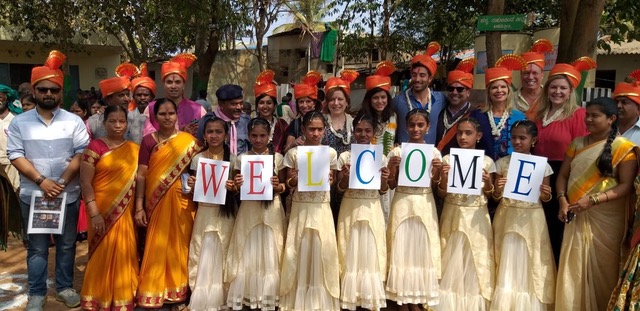


For the past three years, I have been honored to receive an invitation to visit India from our esteemed partners at YUVA Unstoppable, a nonprofit organization serving underprivileged youth. Since the day I met Amitabh Shah and his wife, Rashmi, I have felt connected to their country, to their cause at YUVA Unstoppable, and to them personally. Not to go the journey alone, I took our daughter, Michelle, my right-hand man at Morgridge Family Foundation, John Farnam, his husband, Paul, and three friends who are new to India. The following blog chronicles our February 2019 trip to India. I hope you will see the beauty of the people, the excitement within the schools, and the promise for India’s future.
It was my third year on this route and the flights seemed easy: Denver to New Jersey to Mumbai. I watched a couple of movies, took a sleeping pill, and woke up upon landing. Mumbai has a beautiful new international airport and it only took 30 minutes to clear customs. If it’s your first time in Mumbai, I recommend having a driver meet you at the airport. Since this was our third time, we were comfortable finding a taxi for the short drive to the Taj Santacruz Hotel. Sounds simple enough, yet it took a while to find the taxi stand, order taxis for our group, and then pay by credit card. Most people in India speak English, which makes getting around even easier for us.
We arrived at our hotel at 11 pm and were pleasantly surprised that the hotel restaurant would stay open for us. It happens to be our favorite restaurant in India. We made it to bed by 2 am, which is 2:30 pm in the US. Sleep felt more like a nap when 7 am rolled around. Still, there was time to hit the gym before moving on to a new city.
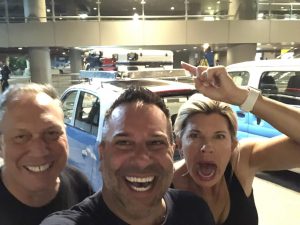
Day 1: We were packed and ready to go when our host, Rashmi Shah, picked us up and took us to a school sponsored by the Morgridge Family Foundation. She arranged two cars for the eight of us and all of our luggage. Michelle and I made the trip to India in a carry on – just saying.
If you have not heard how crazy the freeways are in India, let’s just say that the white stripes are merely a suggestion. There are cars, animals, tuk-tuks, people, and many other things that you will see on the freeway. As a friendly way of letting other drivers know you are close to them, Indians kindly honk their horn, all the time, a million at a time.
We made it safely to the school. The children were waiting for us, dressed in uniform. The band started drumming and we were welcomed to the school as if we were VIPs. A line of children and adults greeted us. As is customary, the children of YUVA Unstoppable adorned our forehead with a red dot. Next, a child safety pinned on a heart that they made, and then a necklace of woven thread is wrapped around our necks. We note the beautiful floor art designed by the children and educators as we walked into the building and up the stairs.

We were shown a remodeled and tech-enhanced classroom alongside many members of the YUVA Unstoppable board. We all experienced the new bathrooms for girls and for boys, as well as the clean water facility. Our group received a demonstration from a Google Certified Educator on their smart classrooms where the computer is inside of the projector, and the white wall is a screen that reacts to touch as if it were a whiteboard. They were accessing Google applications and lessons. Every school that received technology has a Google certified teacher for a full year who teaches both the students and the teachers.
I brought a few copies of my book, The Spirit of the Trail, and sign a couple to give to the YUVA Unstoppable board members while we waited for Lord Jeffrey Archer. I started talking with the young students, many of whom had Chromebooks. I googled my name, and when my face pops up beside my book cover, they immediately ran to the hall to grab their notebooks and asked for an autograph. It was a great time to give a positive message and a copy of my book. The girls all took it a step further and asked each member of our group to not only sign their books, but also add a note.
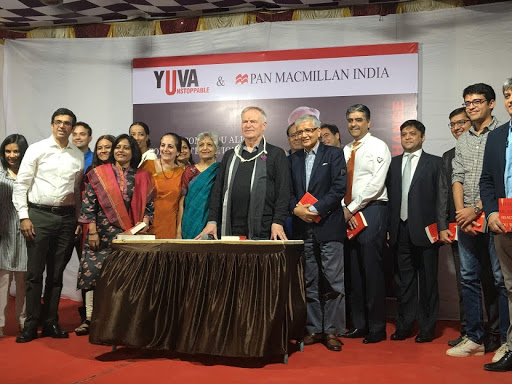
When Lord Jeffrey Archer arrived, we headed up to the assembly with the rest of the school. Parth opened up the morning with the students speaking in their native tongue and then repeating it in English for us to understand.
Lord Jeffrey Archer might be the best public speaker I have ever heard. Brilliant, funny, engaging; at 80 years old, he still has it. I had honestly never heard of him before, but he has sold over 330 million copies of his best selling books. I quickly researched him, and it is not even close to describing the man who stood in front of me. Jeffrey immediately walked to the back of the room where the kids were sitting and engaged them directly. The questions from the students were so authentic. “Do you like my school?” ” Do you like my city?” “Who is your favorite cricket player?” “Who is your hero?” When this last question came out, Jeffrey bragged about how amazing his wife is, how she earned her title of Dame, and how she is the first woman to be Head of the National Sciences in the UK. Jeffrey has a wonderful English accent and such a great silly wit about him. At the end of the program, the adults were asked on stage where Jeffrey gave each of us a signed copy of his book, Heads You Win. It was a great read for the flight back to the US.
After the school site visit, we departed for the YUVA Unstoppable board meeting. When we first got involved three years ago, it took the organization about 10 years to complete 100 schools. To date, they have transformed 850 schools in many different regions of India. Their goal is to transform 10,000 schools by 2020. With their model in place, their goal is achievable. Add in the new Corporate Social Responsibility (CSR) tax, in which profitable companies in India have to give 10% of all revenues to NGO’s, and we can see how Yuva Unstoppable is poised to transform education in India. There is still a long way to go; 1.1 million public schools for 160 million children, about 47% of which need the services that Yuva Unstoppable provide.
Our group departed to the airport on our way to the next city, Hubballi. When we landed, the lack of food and the time change started to hit. Michelle and I were happy to be greeted at the airport by our hosts from the Deshpande Foundation. They even remembered to give us the same driver from last time, and he immediately took us to the hotel. Compared to last year, the freeways and sidewalks of Mumbai and in Hubballi looked noticeably cleaner. We didn’t sit down to lunch until 4:30 pm, and by then we were all starting to fade. There was a 7 pm VIP event scheduled by our next host, Desh Deshpande. In our private meeting with Desh, our eyes began to close and we were taking longer blinks. I tried as hard as I could to be in the moment, but the food and the lack of sleep finally caught up and by 7:15 pm I was comfortably in bed for the night.
A tip when traveling to India: do your activities and meetings in the morning, as you will hit a serious wall in the early evening. It’s ok to go to bed early and start over the next day.
Day 2: Even though I went to bed at 7:15 pm, 5 am came early and we were out the door to visit Akshaya Patra – Unlimited Food for Education. The foundation was started when a man walked by children fighting with street dogs for small scraps of food. He resolved to ensure that no one within a ten-mile radius would ever go hungry, and thus started the foundation. To date, they serve 1.75 million meals per day, six days a week, with a goal of reaching 5 million students by 2020. Last year, revenue was up 19.8%.
A site visit to one of their many kitchens was a must! The kitchen was designed to be gravity fed, which means the food goes down through a vertical assembly line. It’s a concept you have to see to believe. What impressed me most was the improvement they are clearly making, from adding more nutrients to chopping six tons of produce a day.
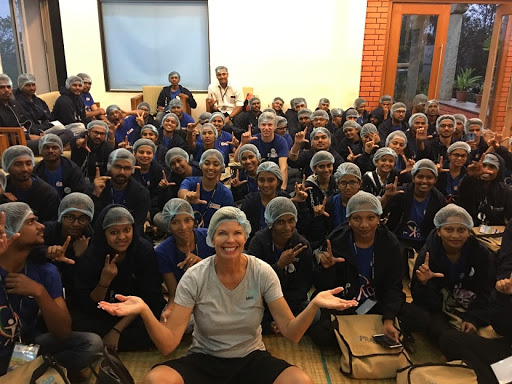
We headed back to the hotel to get ready for the opening of the Deshpande Foundation “Reimagining Impact”. The Annual Development Dialogue brings people together from diverse sectors to make positive change. Desh Deshpande kicked off the event, followed by a beautiful local dance that brought art and happiness to the audience. Meanwhile, Desh described the four sectors his foundation is going to focus on: agriculture, skills for students, entrepreneurship, and micro-entrepreneurship.
What stuck with me most from the opening remarks is how India’s skills gap is the exact opposite of what we hear about in the US. Whereas we are used to seeing higher education as a pathway to job security in the US, employers in India are not necessarily looking at education level as a primary hiring factor. About 60-75% of the jobs available don’t require a 4-year degree, but rather, require skills that are not being taught at university. In fact, the most highly educated college grads in India are only hired at a rate of 5% or so. The Deshpande Foundation is, therefore, reimagining traditional education and creating pathways for local youth to gain entrepreneurial skills and experience.
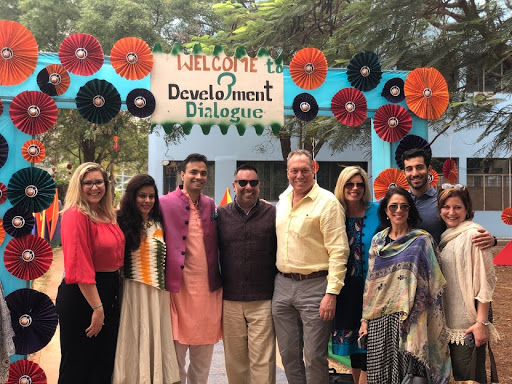
We ventured to our next site visit, a Morgridge Family Foundation school in Hubballi. The school is located in the country slightly further than other schools we have funded in the past. It felt like the entire village was there. We were greeted by the children and drums of the band, red dots were placed on our heads, hearts were safety pinned to our clothes, and necklaces of yarn were hung around our necks. This village went all out, maybe because they knew it was Amitabh’s birthday. We received special hats, a Happy Birthday song, and signs. They showed us the toilets and clean water we gifted to their school. Educators and parents were so grateful for the small yet life-changing amount of work we have done. They wanted selfies with us, and we wanted selfies with them. They put us at the front of the stage for the performance. The children performed dances for us, one by the boys and one by the girls.
When Amitabh went to speak to the students in their native tongue, the kids erupted as he announced our daughter Michelle would be performing a couple of songs. The students didn’t know that Michelle was a camp counselor, and had a couple of songs that they could sing with us. It was a repeat-after-me, do-as-I-do song. As Michelle went on stage, our group decided to back her up. We were all on the stage and the entire village audience was engaged. Once Michelle started, the kids got so excited, they couldn’t wait to sing and act out the song. They joined in on the first round. We had a mixture of English and Indian – and no one cared. It was high energy, lots of love, laughs, and fun. If you want to be remembered at a school – bring your childhood.
As we left, we felt how the school and their community has evolved. A teacher walked me to our car and shares with me how grateful the entire area is for clean water and teacher bathrooms, which they did not have before. I said I am as happy to go to their school as I think they were happy that we came. I hope the children remember Michelle’s songs and think of her coming to India.
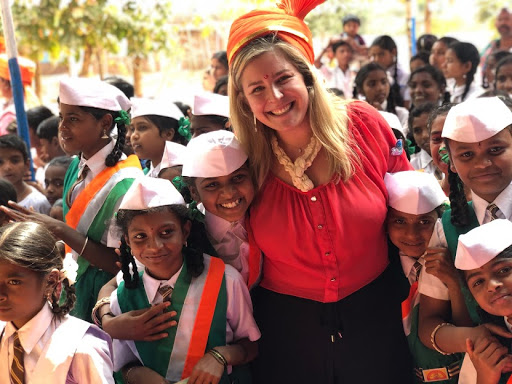
I was scheduled to speak to 1,000 LEAD students at our next stop in the Deshpande program. After leaving the K-8 school, I was totally energized to do something different. We made big changes. I knew I only had 30 minutes –but who wants a stand-up speech after that awesome school visit? When I was introduced, I invited Amitabh Shah to speak with me, and then we brought the fun on stage by having Michelle come up. The stage was raised high, and we could see all of the students. Michelle got the audience excited. So excited, in fact, the students wanted an encore and yelled, “ONE MORE SONG, ONE MORE SONG”. Amitabh and I talked to the students about perseverance and the importance of education. At the end of my time, we got a standing ovation and the moderator said she had never seen anything like it. I brought about 50 copies of my books for the students, and I wished I pre-signed them as Lord Jeffrey Archer did. I was mobbed for a few minutes for books and signatures, but the students were super grateful.
Our next stop was to the market, which I always love. We got to support small businesses that have gone through the Deshpande Entrepreneur program. The average worker in India makes $2 per day (or about 200 rupees) and that number is slowly increasing. The current trade while on the trip is 72 rupees to one US dollar. I exchanged about $40 USD at the hotel, and our entire group showed up ready to shop. We ran out of rupees, but still had USD in small bills, so I negotiated in rupees and added a $1 USD tip. This seemed to work well, and before the end of our shopping spree, all the vendors were taking USD for payment.
With another huge day over, we decided it would be best to skip the big event at InfoSys and celebrated Amitabh’s birthday with a quiet evening of love and friends on the rooftop deck.
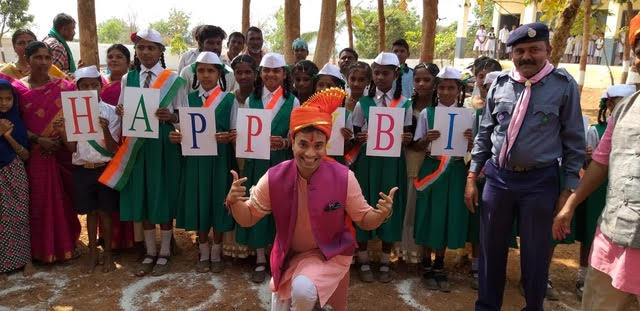
Day 3: Our final day started with some early-morning yoga by the pool. Michelle, who had just completed her 16-week certification for Yoga instruction the week before the trip, agreed to coach us. We picked a quiet spot near the pool and enjoyed the teaching, stretching, and sunrise as we moved our bodies and our minds to the theme of gratitude.

Our final meeting before we headed back to the US was with Humane Society International. I met them the year before when we encountered a street dog who was run over by a moped. Michelle and I rescued the dog, and Humane Society International (HSI) was there to take care of him. Because of that incident, the Morgridge Family Foundation partnered with HSI for a two-year project in Because of that incident, the Morgridge Family Foundation partnered with HSI for a two-year project in Hubballi, Dharwad and Gadag areas of North Karnataka.
As we began our meeting with HSI, there was an immediate connection with the new hires made possible by the Morgridge Family Foundation grant. HSI staff spent an hour debriefing us on their incredible work. We learned that there are laws to protect animals, but the justice department and the local law enforcement needed to be trained on them. Every judge and law enforcement officer had already been engaged within the first year of the two year grant. From there, they shared with us about the dangers of snake bites at night, and what can be done. A simple flashlight can change everything for a family and the snakes.
They shared horrific stories that we can’t repeat, and I asked that they not paint the picture for us, as our hearts and souls would be broken. Many of you know me well and know that I rarely cry. Upon hearing the good that HSI is doing in India, I had a full break down. In their first year of our grant, they rescued or saved over 250,000 animals from abuse. I can feel the change in India, I see fewer street dogs than last year, and I can feel the love and kindness that HSI spreads each and every day. I am pleased to share that we renewed our commitment to them for an additional three years. This gives them a five-year runway to make positive changes in Hubballi and Mumbai.
Ultimately, was it worth a twelve and a half hour time change and a seventeen-hour flight to spend three days in India? We get this question a lot. India was never on my bucket list, and I have yet to see the famous attractions like the Taj Mahal or Bengal tigers. What I have in India are friends who I call our chosen family, and partnerships with great nonprofits who enrich our lives. It is an honor to work alongside such amazing partners, and encouraging to see grant money in India go twice as far as it does in the United States. Every day in India, alongside our chosen family, we live the words of Mahatma Gandhi, “Be the change you wish to see in the world.” My hope for you is that one day you will experience the wonders of India with your own eyes. Believe me, it’s worth the trip.